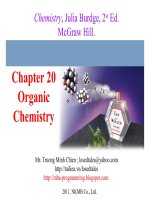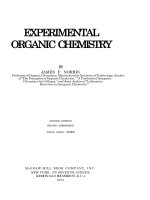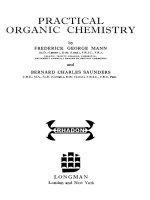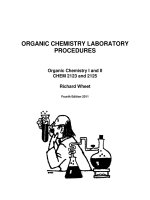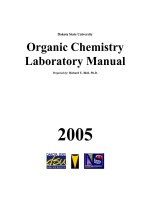Lecture 2 organic chemistry carbon chemistry
Bạn đang xem bản rút gọn của tài liệu. Xem và tải ngay bản đầy đủ của tài liệu tại đây (1.93 MB, 42 trang )
Le ct ure 2 :
Organic Che mist ry:
Carbon Che mist ry
Le t ’s re vie w bonding & Le wis
S t ruct ure s
QuickTime™ and a
decompressor
are needed to see this picture.
What is pencil lead made of if it isn't lead?
• Pencil lead is a mixture
of graphite and clay.
• Graphite is one form of
the element carbon.
• Other forms of carbon
are diamond - the
hardest naturally
occurring substance on
the earth, soot,
charcoal and coke.
What is pencil lead made of if it isn't lead?
• Pencils used to be made with lead, many
years ago. Lead is poisonous and so sucking
the end of your pencil could be quite
dangerous.
• We now use graphite and clay because it is
safer and because we can make pencils of
different hardness
Chemistry of Living Things
• Living things are a lot like laboratories…
• There’s some serious chemistry going on
inside.
• Your body is an incredibly complex chemical
machine taking in chemicals & food, and
causing countless reactions to occur every
second.
• Biochemistry is the study of substances &
processes occurring in all living organisms.
What are living things made of?
I’m made of what???
• Guess how many elements your
body is made up of?
• 25 elements make up all living
things
• About 97% of your body’s mass
is made of just 4 elements:
oxygen, carbon, hydrogen, &
nitrogen.
• Two other major elements are
phosphorous & sulfur.
Minor
Ele me nt s
• Of course, other elements
are also important, but
they’re often found in
small amounts.
• They may seem
insignificant, but they’re
not.
• For example, iron makes
up only 0.004% of your
body mass, but you can’t
live without it!
Major Compounds
• The human body also relies on
many compounds, especially
water & salt.
• The human body typically consists
of 60-65% water.
• In other words, 2/3 of your body
weight is water.
• Water is important because many
of our body’s chemical reactions
can only occur in solutions
containing water.
QuickTime™ and a
TIFF (Uncompressed) decompressor
are needed to see this picture.
Major Compounds
• Blood, sweat, urine…
all mostly water!
• Salt is also important because
of how it can separate into its
two ions: Na+ and Cl-.
• Sodium ions regular the
amount of water in our cells,
while chlorine ions help our
body digest food.
QuickTime™ and a
TIFF (Uncompressed) decompressor
are needed to see this picture.
The most import ant e le me nt is…
Carbon
• If you take away the water, the rest of the human body
is 53% carbon.
• It may not be the most abundant element in living
things, but it certainly is the most important. At one
time, scientists thought that the chemical reactions that
took place inside of living things could not occur
outside of them.
• The carbon molecules were so complex, scientists
thought they must have been made in some unknown
way. They called these carbon compounds organic
compounds
The most import ant e le me nt is…
• The word “organic” has lots
of meanings. Eventually,
scientists realized that the
reactions occurring inside
the body could occur
outside it as well.
• They also learned how
important carbon is in all
living things, because of its
ability to bond with other
atoms.
The most import ant e le me nt is…
• Not all substances made of
carbon are living. Diamonds
& graphite are pure f orms
of carbon.
• Non-organic carbon
compounds, and compounds
without carbon, are called
inorganic compounds.
What is organic
che mist ry?
• We used to describe organic chemistry as the
chemistry of living things.
• Since the chemistry of living things is based
on carbon, the chemistry of carbon
compounds has come to be known as
organic chemistry.
• It now includes the study of carbon
compounds which are not found in living
things and so is an incredibly large branch of
modern chemistry.
Why is lif e base d on t he e le me nt
carbon?
• There are two important properties of carbon
that make it a suitable element to form the
compounds in living things:
• Firstly, carbon atoms can link together to
form stable chains of great length.
Why is life based on the element carbon?
•
Carbon atoms bind
strongly to each other
and f orm very large
molecules which are
built around this
carbon ' backbone ' .
• The covale nt bond between two carbon atoms is
strong so that the backbones are st able . I n all
of these compounds simple sub-units called
monomers are linked together by condensation
reactions.
What make s carbon so spe cial?
• I t has a “central” role in all living organisms.
• I t has 4 vale nce electrons.
• I t makes 4 covale nt bonds.
• I t can bond with any
element,
but really loves to bond with other carbon
atoms and make long chains
Lot s of ways t o draw t his…
3 Type s of Carbon Backbone s
Carbon f orms long chains
• One carbon chain may contain hundreds of carbon atoms.
• Unlike other elements, carbon atoms can bond to each
other to f orm very long chains.
• One carbon chain may contain hundreds of carbon atoms.
Notice how the CH2 units repeat.
• A very large carbon-based molecule made of repeating
units is called a polyme r. Each unit of a polymer is called
a monome r.
• Polymers can be t h ou sa n d s of atoms long
Carbon forms Rings
• Carbon-based molecules also can be shaped like rings.
Most carbon rings contain 5 or 6 carbon atoms.
• One of the most important carbon rings is be nze ne .
• I t has 6 carbons & 6 hydrogens , with alternating
double bonds.
Carbon forms Rings
• Many compounds are based on Benzene.
• They of ten have very strong smells or aromas,
so they are called aromat ic compounds.
• An example of one aromatic compound is a
molecule called vanillin.
• Guess what that smells like!
•You have
probably
heard lots
of science
f iction
programs
on TV
talking
about
human
beings as
' carbonbased lif e
f orms' .
Prepare to be assimilated…
